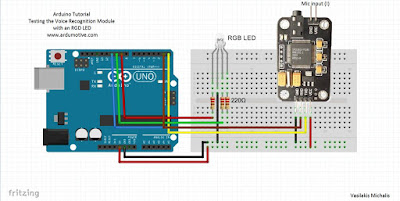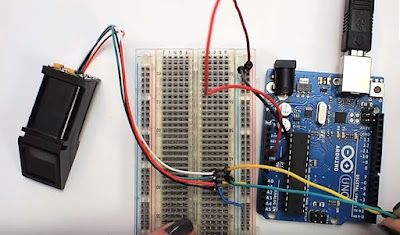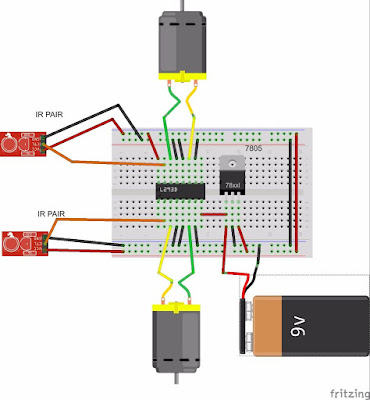Arduino and Android Voice control Robot
In this touturial about How to make a voice control robot. voice controlled robot and is controlled via Bluetooth HC-05 through a smartphone applicaton. In this application is developed in such a way that it converts the voice command to text and transfer the text to the connected Bluetooth device
Required Components:
Bluetooth module ----------- Arduino:
Vcc ----------- +5v
GND ----------- GND
Tx --------------- pin 10
Rx --------------- pin 11
- Arduino Uno
- Bluetooth Module
- L293D Motor Driver
- 2x Gear Motor
- 2x Wheel
- 1x Chasis
- A breadboard
- Connecting wires
Circuit Diagram :
Bluetooth module ----------- Arduino:
Vcc ----------- +5v
GND ----------- GND
Tx --------------- pin 10
Rx --------------- pin 11
Voice Control Bot App:
Here in this link is the app developed using MIT app inventor:
Here in this link is the app developed using MIT app inventor:
Click here to download Android app
This is a simplified version of any other voice control robot, No complex coding easy to understand coding with easy algorithm.
The app is developed in such a way that it convert the voice command to text and transfer the text to the connected Bluetooth device
Source Code:
Arduino Program for voice control robot.
_________________________________________________________________________________
#include <SoftwareSerial.h>
SoftwareSerial BT(10, 11); //TX, RX respetively
String readvoice;
void setup() {
BT.begin(9600);
Serial.begin(9600);
pinMode(3, OUTPUT);
pinMode(4, OUTPUT);
pinMode(5, OUTPUT);
pinMode(6, OUTPUT);
}
//-----------------------------------------------------------------------//
void loop() {
while (BT.available()){ //Check if there is an available byte to read
delay(10); //Delay added to make thing stable
char c = BT.read(); //Conduct a serial read
readvoice += c; //build the string- "forward", "reverse", "left" and "right"
}
if (readvoice.length() > 0) {
Serial.println(readvoice);
if(readvoice == "forward")
{
digitalWrite(3, HIGH);
digitalWrite (4, HIGH);
digitalWrite(5,LOW);
digitalWrite(6,LOW);
delay(100);
}
else if(readvoice == "reverse")
{
digitalWrite(3, LOW);
digitalWrite(4, LOW);
digitalWrite(5, HIGH);
digitalWrite(6,HIGH);
delay(100);
}
else if (readvoice == "right")
{
digitalWrite (3,HIGH);
digitalWrite (4,LOW);
digitalWrite (5,LOW);
digitalWrite (6,LOW);
delay (100);
}
else if ( readvoice == "left")
{
digitalWrite (3, LOW);
digitalWrite (4, HIGH);
digitalWrite (5, LOW);
digitalWrite (6, LOW);
delay (100);
}
else if (readvoice == "stop")
{
digitalWrite (3, LOW);
digitalWrite (4, LOW);
digitalWrite (5, LOW);
digitalWrite (6, LOW);
delay (100);
}
readvoice="";}} //Reset the variable
_________________________________________________________________________________
_________________________________________________________________________________
#include <SoftwareSerial.h>
SoftwareSerial BT(10, 11); //TX, RX respetively
String readvoice;
void setup() {
BT.begin(9600);
Serial.begin(9600);
pinMode(3, OUTPUT);
pinMode(4, OUTPUT);
pinMode(5, OUTPUT);
pinMode(6, OUTPUT);
}
//-----------------------------------------------------------------------//
void loop() {
while (BT.available()){ //Check if there is an available byte to read
delay(10); //Delay added to make thing stable
char c = BT.read(); //Conduct a serial read
readvoice += c; //build the string- "forward", "reverse", "left" and "right"
}
if (readvoice.length() > 0) {
Serial.println(readvoice);
if(readvoice == "forward")
{
digitalWrite(3, HIGH);
digitalWrite (4, HIGH);
digitalWrite(5,LOW);
digitalWrite(6,LOW);
delay(100);
}
else if(readvoice == "reverse")
{
digitalWrite(3, LOW);
digitalWrite(4, LOW);
digitalWrite(5, HIGH);
digitalWrite(6,HIGH);
delay(100);
}
else if (readvoice == "right")
{
digitalWrite (3,HIGH);
digitalWrite (4,LOW);
digitalWrite (5,LOW);
digitalWrite (6,LOW);
delay (100);
}
else if ( readvoice == "left")
{
digitalWrite (3, LOW);
digitalWrite (4, HIGH);
digitalWrite (5, LOW);
digitalWrite (6, LOW);
delay (100);
}
else if (readvoice == "stop")
{
digitalWrite (3, LOW);
digitalWrite (4, LOW);
digitalWrite (5, LOW);
digitalWrite (6, LOW);
delay (100);
}
readvoice="";}} //Reset the variable
_________________________________________________________________________________


















